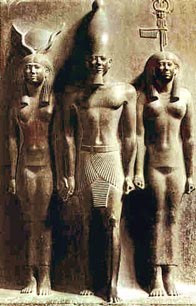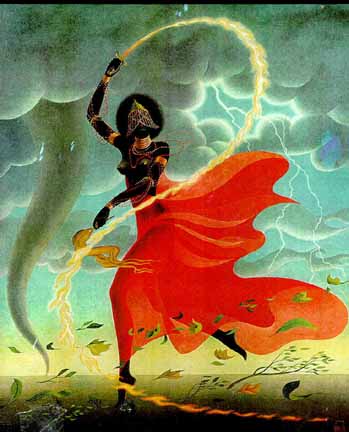Heru, also known as Horus or Har, was one of the most important and widely worshipped gods in ancient Egyptian religion. He was the god of the sky, kingship, and war, and was often depicted as a falcon or a falcon-headed man.
According to ancient Egyptian mythology, Heru was the son of Osiris and Isis, the divine king and queen of Egypt. After his father was murdered by his jealous brother, Seth, Heru sought revenge and engaged in a fierce battle with Seth. In the end, Heru emerged victorious and became the ruler of the world, taking his place as the god of the sky and protector of the pharaohs.
Heru was associated with the sun and was often depicted as a falcon perched on the sun disk. He was also associated with the sky, and was said to protect the pharaohs and the people of Egypt from the dangers of the world below.
In many of his depictions, Heru is shown holding the ankh, the symbol of life, and the scepter, a symbol of power and authority. He was also often depicted wearing the double crown of Egypt, which symbolized the unity of Upper and Lower Egypt.
His role as a protector and defender of the pharaohs, Heru was also associated with kingship and the rule of law. He was seen as a fair and just ruler, and was invoked in legal matters to ensure that justice was served.
Despite the passage of time and the many changes that have occurred in the world, the god Heru remains an important figure in the pantheon of ancient Egyptian deities. His legacy can still be seen in many aspects of modern culture, from his depiction in popular media to his continued presence in contemporary spiritual practices.
In addition to his role as a god of kingship, Heru was also associated with the sun, as the falcon is a solar symbol. As such, he was seen as a guardian and protector, and was often invoked in times of war.
The reason why Heru was depicted with a falcon head has its roots in ancient Egyptian mythology and beliefs. The falcon was a powerful symbol in ancient Egypt and was associated with several aspects of life, including the sky, the sun, and hunting. The bird was also seen as a symbol of power, strength, and swiftness, which made it a perfect representation of the god of the sky, kingship, and war.
The falcon was believed to have the ability to soar to great heights and see things that were hidden from view, making it a powerful symbol of perception and insight. These attributes were also associated with Heru, who was seen as a protector and guide who could see and understand the world in ways that were beyond the reach of mere mortals.
As a result of these beliefs, Heru was often depicted with a falcon head, which helped to emphasize his divinity and the powerful role he played in the lives of the ancient Egyptians. This depiction of Heru as a falcon-headed deity was widely recognized and has remained a staple of ancient Egyptian art and iconography for centuries.
Heru was an important deity in the Kemetic tradition, and his cult center was located at the city of Nekhen, in Upper Egypt. He was often depicted in art and literature, and was the subject of many hymns, prayers, and offerings.
It’s also worth mentioning that Heru played a significant role in the afterlife as well. In the Egyptian Book of the Dead, Heru was seen as a guide for the deceased, helping them navigate the dangers of the afterlife and reach their final destination. He was also considered a savior figure and was depicted in scenes of the weighing of the heart ceremony, where the heart of the deceased was weighed against the feather of Ma’at, the goddess of truth and justice.
Heru’s story and symbolism continued to evolve over time and his worship spread to other parts of the ancient world, such as Greece and Rome. Heru’s name was later associated with the Greek god Horus and was syncretized with other deities, including the Roman gods Mars and Jupiter.
Overall, Heru played a vital role in ancient Egyptian religion, and his legacy continues to be felt in modern times, both in popular culture and in spiritual practices.

